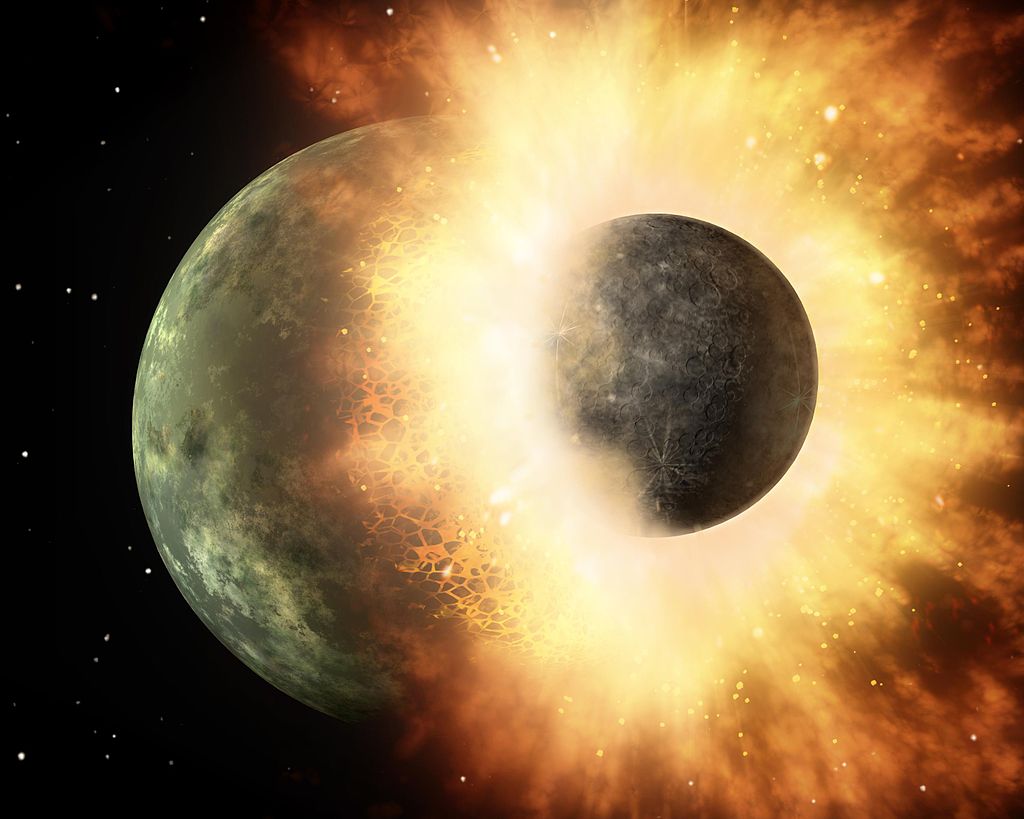Image credit: NASA/ JPL-Caltech
So what if the Earth crashed into another planet? And…could that actually happen?
Earth’s violent past
One thing we know for sure: it did happen before! The young Solar System was a crowded place with lots of planet size objects flying about. One of the most favorable theories of the Moon formation suggests that around 4.5 billion years ago the Earth crashed into a Mars-sized protoplanet nicknamed Theia. Over time, the bits of the destroyed body and chunks of the early Earth that were thrown into orbit during collision stuck together, cooled down and became the Moon. So, as you see, the collisions are not necessarily a bad thing. But it’s best to stay a safe distance away when they happen.
Stability of the planets in the Solar System
At the moment all the remaining Solar System planets are settled on their relatively stable orbits.
BUT we can only talk about the “stability” of the orbits on a small (in cosmic terms) timescale. The stability of the Solar System is a fundamental problem of celestial mechanics, known as N-Body Problem. This problem has no analytical solution, except for the special case of 2-body problem. Numerical simulations show that the Solar System is in fact CHAOTIC on a timescale of some millions of years. Meaning that if you change the initial parameters by a small amount, with the time the “difference” will accumulate leading to a completely different outcome for the Solar System. Luckily, most of these variations do not lead to any planetary collisions. But a few of the Solar System “simulated futures” tell us a different story. And the troubles there come from the smallest planet of all!
Mercury
Mercury is a bizarre little planet. It has the most eccentric orbit of all the planets in the Solar System. The simulations show that there is a tiny, about a 1% chance that the planet’s eccentricity will increase even further in the future. That, in turn, could result in a collision between Mercury and either Sun, Venus or Earth. Alternatively, it could destabilize the gravitational balance in the Solar System causing a crash between Earth and Venus or Earth and Mars (see A simple model of the chaotic eccentricity of Mercury for more information).
Conclusion
Astronomers say that there is a 99% chance the Solar System planets are not going to collide before the death of our Sun.
Rogue planets
Another extremely unlikely possibility is that a rogue planet will cross paths with the Earth one day. Rogue planets are cosmic wanderers that orbit the center of a galaxy and are not bound to any star. They are thought to have been ejected from their star system or, possibly, just born alone. Astronomers estimate that there might be billions of rogue planets in the Milky Way alone. But because these objects are very cold and dim, only few of them have been discovered and confirmed. The best chance to detect a nomad planet is through gravitational microlensing. All the known rogue planet candidates are located tens to hundreds of light years away from the Solar System. To compare, the nearest star system to the Sun, Alpha Centauri, is 4.3 light years away.
Conclusion
The vast space distances, the small size of our planet and the fact that such events never happened in the entire 4.6 billion year long history of the Solar System make us pretty confident that the Earth is quite safe from the surprising and possibly fatal encounter with a rogue planet.
So, is there a chance the Earth will crash into another planet? Yes, but a very slim one! Phew!
More information
Visit our inflatable star dome, send your questions to our portable planetarium team and check out our Space Blog!

